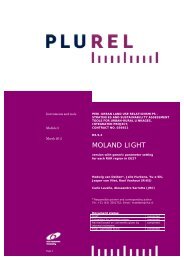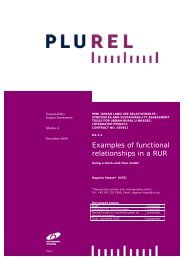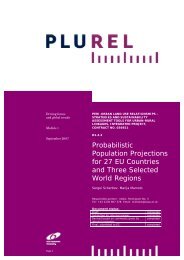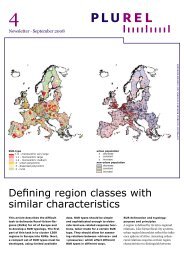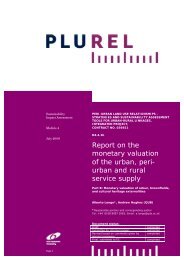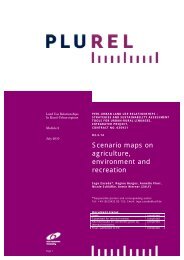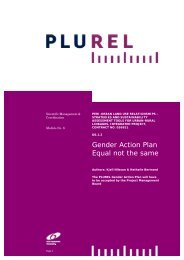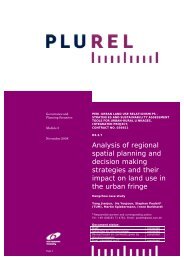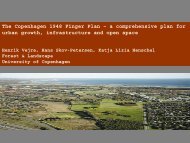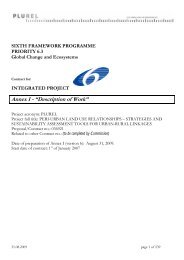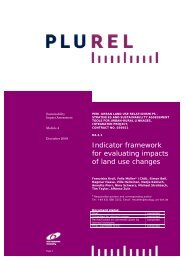Cost benefit analysis of peri-urban land use policy - Plurel
Cost benefit analysis of peri-urban land use policy - Plurel
Cost benefit analysis of peri-urban land use policy - Plurel
You also want an ePaper? Increase the reach of your titles
YUMPU automatically turns print PDFs into web optimized ePapers that Google loves.
Table 12: Current Data on Agricultural Production in UK<br />
Type <strong>of</strong> crop Yield (2004-2008<br />
national average)<br />
(tonne/ha/year) ‡<br />
Price (2004-2008<br />
average price in the<br />
UK) (2008£/tonne) <br />
Gross<br />
margin (%<br />
<strong>of</strong> output) †<br />
Proposed<br />
share <strong>of</strong><br />
crop areas §<br />
Wheat 7.9 159 57% 51%<br />
Barley<br />
26%<br />
5.8 127 61%<br />
(winter/spring)<br />
Oilseed rape 3.2 315 54% 16%<br />
Potatoes 41.9 148 61% 4%<br />
Sugar beet 58.1 21 55% 3%<br />
Data sources: ‡ FAOSTAT database; FAOSTAT database; † authors’ own calculation from the data<br />
available in The agricultural budgeting & costing book 2008 and 2008/09 Farm Business Survey<br />
(FBS) database ; § Agriculture in the United Kingdom 2009)<br />
This study considers potential changes in agriculture production as a result <strong>of</strong> climate change<br />
and socio-economic effects in the future. We apply the projected scales <strong>of</strong> changes in crop yields<br />
and the corresponding production prices that were available in the REGIS model. This model<br />
was developed to estimate regional climate change impact and response <strong>of</strong> several sectors,<br />
including coast, water, biodiversity and agriculture in East Anglia and North West Eng<strong>land</strong>, and<br />
more details are available in the technical report (RegIS, 2001).<br />
Table 13 exhibits the projected relative changes in the levels <strong>of</strong> yields and prices by types <strong>of</strong><br />
crops and future scenarios. Note that these are not region-specific. We obtain projected yields<br />
and prices by scaling up or down the historical figures in years 1997/1998. For example, the<br />
yield <strong>of</strong> wheat in 1997/1998 was 7.5 tonne/ha, and accordingly, the projected yield <strong>of</strong> wheat in<br />
2020s is 10.5 tonne/ha (7.5*140/100) in A1 scenario. As far as production price is concerned,<br />
the price <strong>of</strong> wheat in 1997/98 was £83.24/tonne (1997£) and is projected at around<br />
£111/tonne (2008£) in scenario A1 in 2020s. Price levels are adjusted according to agriculture<br />
price indices available in Defra database. Assuming that gross margin rates remain constant<br />
in the future, we estimate the gross margin per ha for each type <strong>of</strong> crops in 2020 and 2025<br />
(both years are considered in the <strong>peri</strong>od <strong>of</strong> 2020s).<br />
Page 41 • PLUREL report No 4.4.3 • December 2010



